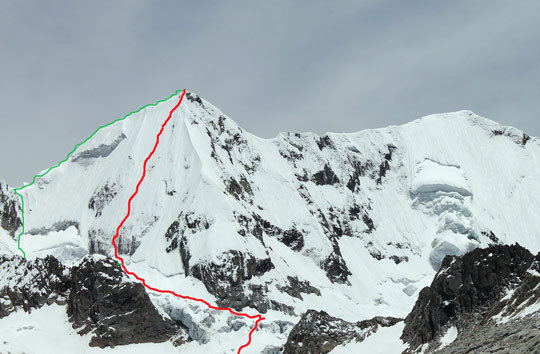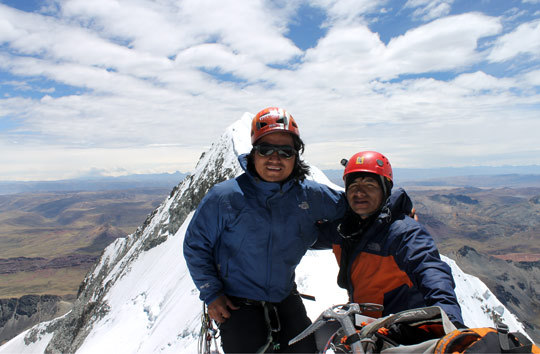
Chinita (MD+ 90-degree ice and rock), Tunsho South (5560m), Cordillera Central, Peru. Last fall, local climbers Beto Pinto Toledo and Rolando Morales Evangelista established this line on the unclimbed south summit of Tunsho. [Photo] Beto Pinto
After a few months and a mountain of research, Beto Pinto Toledo decided that the summit of Tunsho South (5650m), in Peru’s Cordillera Central, had never been reached. Pinto and partner Rolando Morales Evangelista established a new line, Chinita, up to the peak’s south summit last fall. Chinita is graded at MD+ with 90-degree ice and rock.
The Cordillera Central, in the interior of Peru near the city of Junin, is one of the least known of the Peruvian ranges due to its distance from major cities. The mineral-rich peaks are subject to several intensive mining projects and associated environmental implications. Tunsho itself comprises two peaks, the northern summit and the lower southern summit. The broadest faces are the east- and west-facing aspects. Almost entirely covered by glacial ice, the east face has the biggest ice wall in the range. In contrast, exposed andesite rock characterizes the west face.
While climbing Norma Mountain last year, Pinto spotted Tunsho’s intriguing walls of rock and ice, and set about investigating its history. He found that one Peruvian expedition had reached the northern summit via the west face, and another expedition planned a route up the north ridge, but an accident on the climb prevented them from reaching their goal. Pinto found no record of ascent to the south summit.

Pinto leading in the pre-dawn. [Photo] Beto Pinto
Having established that the south summit was unclimbed, Pinto traveled to Huancayo with Morales last October to gather more information. On October 16 they took the four-hour drive and made camp by a lake at 4700m. The next day the pair decided to attempt the peak. They started just after midnight reaching the base of the wall around 3 a.m.
They moved slowly through the first section, which had a “fresh snow roof” and vertical rock climbing. The snow improved higher up, with some areas of blue ice, and faster climbing. The final two pitches were more difficult. Loose snow at eighty to ninety degrees consumed a lot of time on the final section. They reached the summit around 9 a.m. and, having caught their breath and taken in the view, they rappelled the south ridge to a col. Intending to go for the east summit, “weather conditions deteriorated and, after climbing about a hundred meters, we decided to turn back.”
Through the ascent, Pinto hopes to “draw attention to this little visited range, because there are a lot of great peaks to climb. And perhaps by generating interest in its tourist potential we can help to protect the area from the damaging effects of intensive mining.”

Morales and Pinto on the summit of Tunsho South. [Photo] Beto Pinto